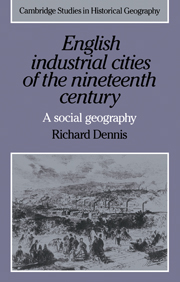Book contents
- Frontmatter
- Contents
- List of Figures
- List of Tables
- Preface
- A note on prices and distances
- 1 Urban geography and social history
- 2 Sources of diversity among Victorian cities
- 3 Contemporary accounts of nineteenth-century cities
- 4 Public transport and the journey to work
- 5 The geography of housing
- 6 Class consciousness and social stratification
- 7 The spatial structure of nineteenth-century cities
- 8 Residential mobility, persistence and community
- 9 Community and interaction
- 10 The containing context
- Notes
- Bibliography
- Index
7 - The spatial structure of nineteenth-century cities
Published online by Cambridge University Press: 05 January 2010
- Frontmatter
- Contents
- List of Figures
- List of Tables
- Preface
- A note on prices and distances
- 1 Urban geography and social history
- 2 Sources of diversity among Victorian cities
- 3 Contemporary accounts of nineteenth-century cities
- 4 Public transport and the journey to work
- 5 The geography of housing
- 6 Class consciousness and social stratification
- 7 The spatial structure of nineteenth-century cities
- 8 Residential mobility, persistence and community
- 9 Community and interaction
- 10 The containing context
- Notes
- Bibliography
- Index
Summary
The purpose of this chapter is to investigate how far recent geographical scholarship has, or could, confirm hypotheses about spatial structure arising from the conclusions of the previous chapters. Emphasis is placed on spatial structure as an expression of social and economic structures. In the final chapters more attention is paid to spatial structure as the framework within which society functions, space as an independent variable constraining or encouraging movement and interaction.
In Chapter 3 it was shown how middle-class observers in the early Victorian period saw their cities as ‘increasingly segregated’ and, by the end of the century, took the segregation of rich and poor for granted. But it seemed probable that their comments reflected changing perceptions as much as any changing realities, since descriptions of quite different urban environments and from different periods proved so similar. Personal experience of segregation was more important than its statistical measurement. To many contemporaries, rich and poor were highly segregated even though they lived very near to one another. A first task for our generation of historical geographers, therefore, is to compare these perceptions with the ‘objective reality’ offered by census returns and other population listings.
Later in the nineteenth century there was more interest in residential differentiation within the working classes, associated with the upward social mobility of a lower middle class, the emergence of a labour aristocracy and the critical distinction between the regularly and casually employed, or the respectable and the residual poor.
- Type
- Chapter
- Information
- English Industrial Cities of the Nineteenth CenturyA Social Geography, pp. 200 - 249Publisher: Cambridge University PressPrint publication year: 1984



